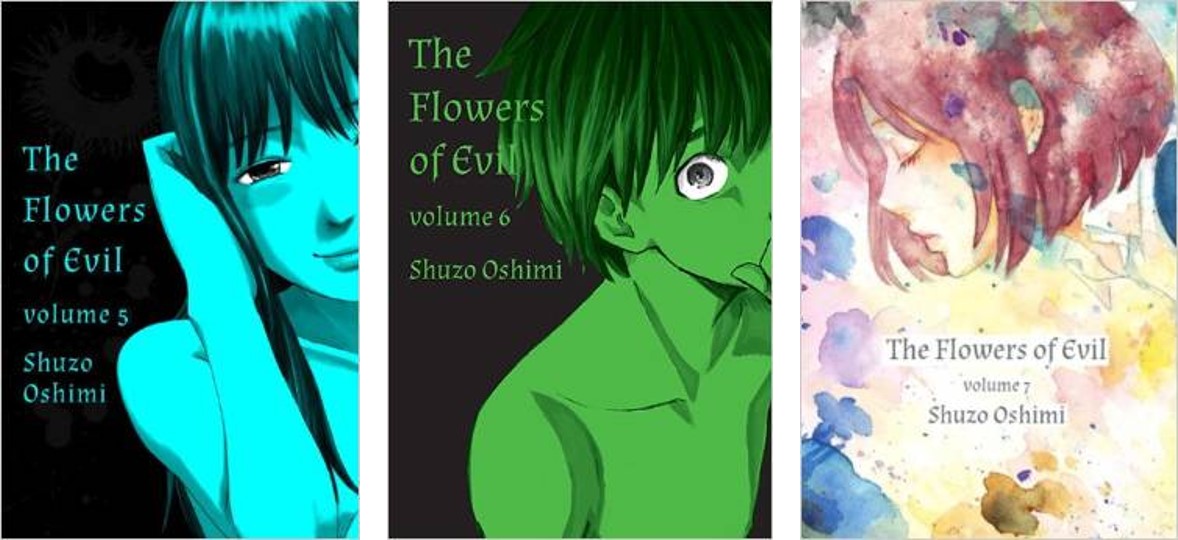25 Oct / The Flowers of Evil (vols. 5-7) by Shuzo Oshimi, translated by Paul Starr

 First, to catch up: click here for previous volumes (all of which, of course, you need to read for yourself). If these covers placed next to each other above are a bit jarring, I think I might have unintentionally, wrongly grouped the latest volumes together.
First, to catch up: click here for previous volumes (all of which, of course, you need to read for yourself). If these covers placed next to each other above are a bit jarring, I think I might have unintentionally, wrongly grouped the latest volumes together.
Let me explain … The full series has nine total installments, with each third getting a distinct look for their covers. While our conflicted young man, Takao Kasuga, is clearly the protagonist throughout, the object of his primary obsession shifts with each third. The ‘pure,’ simple, mostly black-and-white covers for volumes 1-3 reflect Kasuga’s obsession with the outwardly perfect Nanako Saeki who is so ‘good,’ she seems to have little depth. The deeply infused colors of volumes 4-6 echo the intensity of Kasuga’s growing dependence on the volatile, violent Sawa Nakamura. In volume 7, as seen above, Kasuga’s latest shift to a new schoolmate who reignites his love of literature, begets a whole new artsy watercolored look, surely reflecting the potential and promise of a new future.
Since that explanation revealed a few important narrative details, allow me to back up with just a few fillers …
As summer break quickly approaches in volume 5, Kasuga and Nakamura plot together in their hideout – decorated with a clothesline of stolen panties – to do “something that’ll wake up the people in this town all at once.” Jealousy drives Saeki to the hideout … where she confronts Kasuga with a shocking plan of her own. In volume 6, Kasuga must finally face not only his understandably frantic parents, but his school’s administration, as well. Still, all those adult eyes on him are not enough to attempt a dangerous final act with unstoppable Nakamura.
Volume 7 opens with a spectacular summer festival blow-out (so to speak), and quickly moves to a new grade and new school for longer-haired, reticent Kasuga. After being assaulted on a dark street one night, he aimlessly wanders into a used bookstore, where he recognizes a classmate holding a book in her hand … none other than Baudelaire’s The Flowers of Evil. His reaction is so severe, she warns, “Hey, you’re creeping me out! Just calm down!!” Trying to rein in his excitement, Kasuga’s bookish new relationship begins.
Readers with children beware: every nightmare associated with disgruntled adolescence gets magnified in these volumes. With friends so toxic, an environment so lax, and the adults so clueless, if manga like Flowers of Evil is any indication, contemporary youth face more challenges to reaching adulthood with their sanity and humanity intact that ever before. Read, be afraid, then use these stories as a primer for how-not-to-parent.
Readers: Young Adult, Adult
Published: 2013 (United States)
